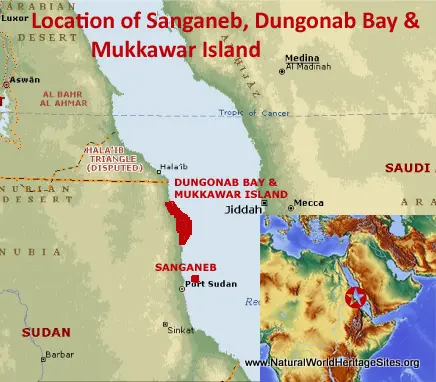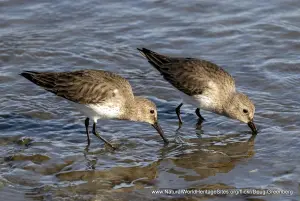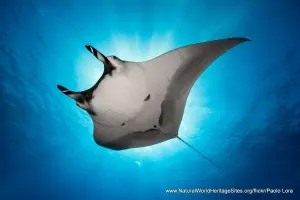EXPLORE Sanganeb Marine National Park and Dungonab Bay – Mukkawar Island Marine National Park with this slideshow, check the location map and get all the facts and information below.
For slideshow description see right or scroll down (mobile). Click to view slideshow
Location and Values: Sanganeb Marine National Park and Dungonab Bay – Mukkawar Island Marine National Park are two components of this serial site, located along Sudan’s coast in the central part of the Red Sea. This is the only world heritage site in the Red Sea, a globally outstanding area which is the world’s northernmost tropical sea, as well as being its warmest and most saline sea. Sanganeb is the Red Sea’s only known atoll, rising from a depth of 800m with steep slopes, terraces, spurs and pillars supporting 13 distinct reef zones each with a different assemblage of coral species. The Dungonab Bay – Mukkawar Island area, 125 km further north, is quite different, with an array of terrestrial and marine habitats including beaches, islands and islets, coral reef complexes, mangroves, seagrass beds and intertidal areas. Here there is a globally significant population of dugongs, as well as an abundance of other marine mammals, seabirds, fish, sharks, turtles and manta rays
Conservation Status and Prospects. According to IUCN’s Conservation Outlook Assessment (2020) the conservation status of the Sanganeb Marine National Park and Dungonab Bay – Mukkawar Island Marine National Park is ‘good, with some concerns’. In general, the remote location, low levels of human activity and difficult access provide a high degree of natural protection and the site is in a near-pristine condition. There are few significant threats, although the Sudanese coast is reported to have some of the highest recorded instances of coral bleaching in the whole of the Red Sea and this has the potential to become more serious with anticipated further global warming. In addition to the emerging threats from climate change, fishing activities by local communities are causing a certain amount of damage to corals from boat anchors, and some species of conservation concern are accidentally caught in fishing nets. Three further concerns are (1) the overharvesting of mangroves as camel fodder, (2) improved access due to road developments along the coast, and (3) the increasing number of oil tankers passing through the Red Sea close to the site with corresponding risks of an oil spill.
Links:
Google Earth
Official UNESCO Site Details
IUCN Conservation Outlook
UNEP-WCMC Site Description
Birdlife IBA
Slideshow description
The slideshow ‘tells the story’ of the Sanganeb Marine National Park and Dungonab Bay – Mukkawar Island Marine National Park with a portfolio of photos that illustrate the land and sea-scape features of this outstanding place, together with its diverse marine life. The slideshow starts with views of the reefs at Sanganeb from above, with photos of the famous lighthouse and jetty that provides access to the underwater world. Some of the bigger inhabitants of the waters nearby, including dolphins, manta rays, sharks and barracuda are shown.
The next part of the slideshow illustrates the Dungonab Bay – Mukkawar Island area, starting with a modest boundary sign board, and a fossilised clam shell embedded in the raised beach along the barren shoreline, a stand of mangroves, followed by a series of underwater photos of dugongs and turtles feeding on the seagrass beds in this part of the site. The rest of the slideshow illustrates the diversity of underwater life, with brightly coloured corals, other invertebrates and fish of every kind – angels, clown anemone fish, lion fish, bump-head parrot fish, moray eels and many other species.
The following Flickr photographers and other sources are acknowledged with thanks for their contributions to this slideshow: Antonio, AO’D, Brian Gratwicke, Bubak, Elias Levy, Fergus Kennedy, FulB76, Julie Burgher, KarinHS, Matthhijs Rouw, Nataraj Metz, Pablo Sarasa, Robin Hughes, Rutger Geerling, Ruth Hartnup, Silvie Gilson, Silvio Pastore Stocchi, Sven Roden, Svetoslav Bonev, Tim Priest, UNEP and William Doriat.
Factfile
Website Category:
Marine & Coastal
Area: 2,607 km2
Inscribed: 2016
UNESCO Criteria:
- Outstanding natural beauty (vii);
- Ecological processes (ix);
- Natural habitat for biodiversity (x);
- Significant number of rare, endemic and/or endangered species (x)





